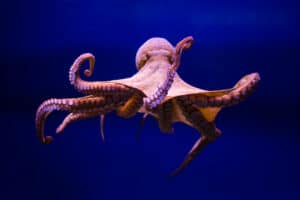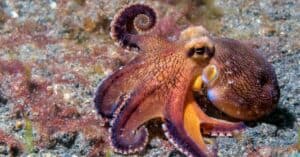Octopuses are remarkable creatures that have captivated humans for centuries. From their unique physical appearance to their mysterious behavior, octopuses have much to teach us about the natural world. These fascinating animals have eight arms with suckers, three hearts, blue blood, and the ability to camouflage themselves by changing color and texture. But how do octopuses mate?
Let’s explore the fascinating mating habits, complex courtship rituals, and reproductive processes of these enchanting animals!
Finding a Mate
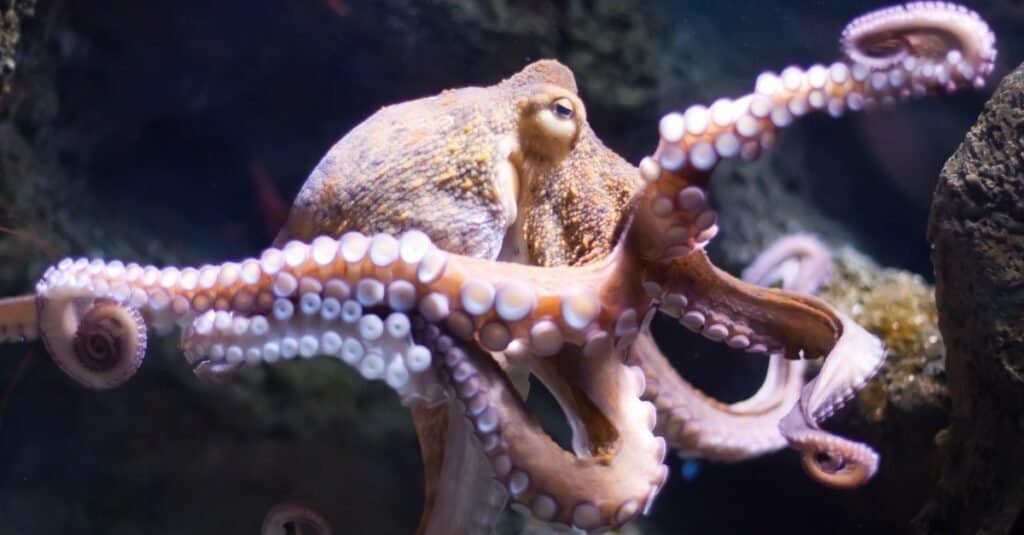
There are more than 300 species of octopus in the world.
©iStock.com/aurigadesign
Although there are over 300 species of octopus, scientists have only observed the mating behavior of about twelve of them. Most octopuses live alone and look for food and hide from predators until it comes time to reproduce. How they manage to find each other to mate remains an intriguing mystery as they spend their childhood alone and have no parents or mentors to guide them.
Once an octopus has grown up, they go looking for a partner instead of being alone. However, octopuses are masters of camouflage, so it can be difficult to find a mate that’s just as good at hiding as they are. Males invest a lot of time and effort into searching for a mate, while females remain relatively inactive. Males must often search far and wide for females, as octopuses tend to spread out in the water.
During the mating season, males will display behaviors such as swimming around in circles or flashing their colors to attract potential mates. However, due to the vastness of the oceans and their nomadic nature, it can be difficult for them to locate one another. It is possible that females attract males using chemical signals, but we still aren’t entirely how this works.
Octopus Courtship
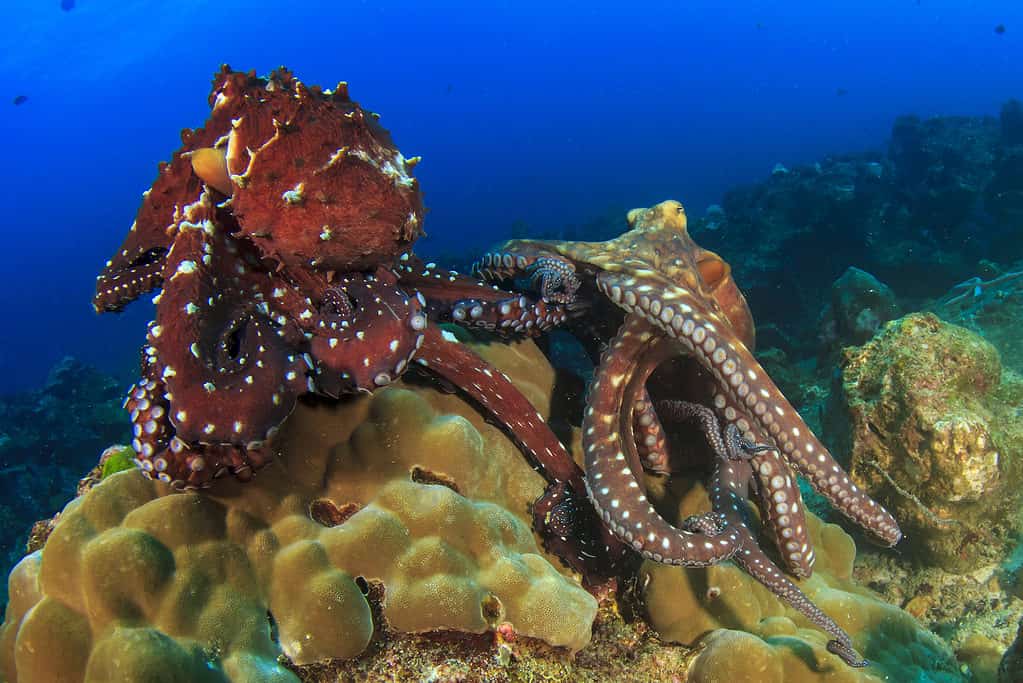
Octopus mating has only rarely been observed in the wild.
©iStock.com/richcarey
Since finding a mate is such a challenge, female octopuses are pretty open-minded and do not often turn a male away. While a male’s size, color, and appearance may play some role in their selection process, females tend not to be overly picky about who they mate with.
However, finding a mate is not always simple or straightforward. Octopuses have complex mating rituals, and male octopuses must be very careful when mating. A rival male could come and try to take away his mate, or the female might decide to eat him!
Each species of octopus has their own special courting rituals. For example, the male day octopus (Octopus cyanea) is quite a show-off! He stands tall and towers over his potential mate, turning a pale color. When he gets close to a female, he’ll flash a pattern of black stripes across his body to let her know that she’s looking at a male octopus!
It may seem strange to us, but it isn’t so easy to tell a female and a male octopus apart. For example, a male prickly octopus (Abdopus aculeatus) has a special way of telling if they are male or female. Males show black and white stripes on their bodies when they are near a female or fighting. However, some males also use this same pattern to trick the guarding male and mate with the female in secret! These deceptive male prickly octopuses are called “sneakers.” Sneakers change the color of their body so that they look like a female octopus. This allows them to sneak up and steal a female octopus to mate with without being detected!
How Do Octopuses Mate?
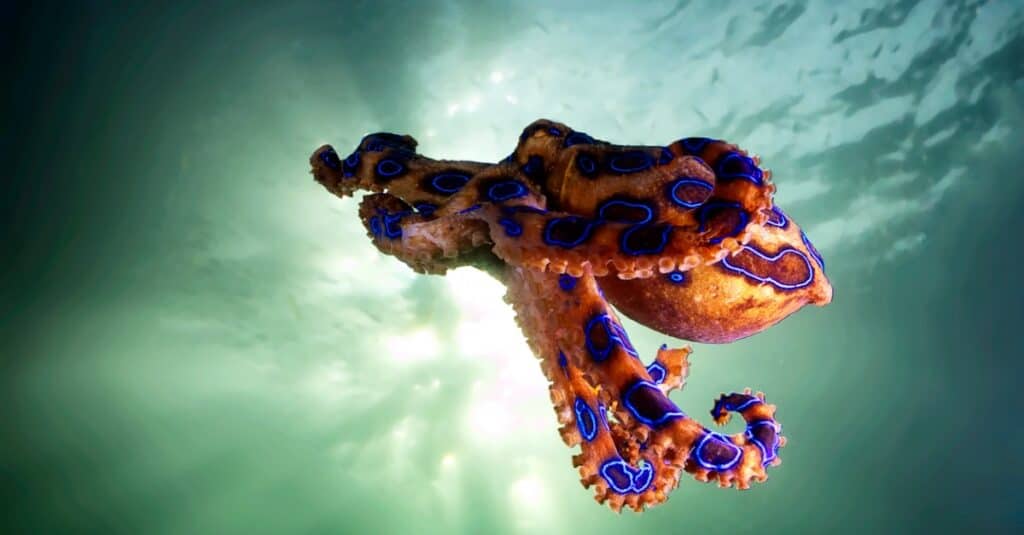
Mating in octopuses is highly specialized depending on the species.
©iStock.com/Subaqueosshutterbug
Female octopuses can be a bit rough during mating. In some cases, they may even eat their mate, either while they are mating or once they are done! To stop this from happening, scientists believe that male octopuses developed a special arm called the hectocotylus to help them keep their distance when mating with a female octopus. The hectocotylus is a modified arm that a male octopus uses to place a pack of sperm into a female octopus’ mantle cavity.
To mate, octopuses often engage in a mating dance of sorts. They will swim in circles around each other and even change their color pattern to signal their interest. After the two octopuses have connected, the male will insert his modified arm — the hectocotylus — into the female’s mantle cavity, which contains her eggs. The male will then release sperm which fertilizes the eggs.
Sometimes female octopuses mate with many different males and store the sperm until they are ready to lay their eggs. Once the eggs are fertilized, the female octopus diligently guards them until they hatch. She doesn’t even take a break to get something to eat!
The Larger Pacific Striped Octopus
Although female octopuses often eat their male partner after mating, the larger Pacific striped octopus (which has yet to receive a scientific name) does things a little differently. Unlike many other octopus species, the larger Pacific Striped Octopus often lives in groups, sometimes with as many as 40 other octopuses!
In addition, most types of female octopuses die once their eggs hatch. However, that is not the case for larger Pacific striped octopuses. These octopuses mate very often and the females can lay eggs over a period of many months.
Moreover, most other octopuses stay at arm’s length when they mate (males do this to keep from being eaten!), but larger Pacific striped octopuses are a bit more intimate. They press their beaks together like they’re kissing, and touch their suckers together like they’re giving each other a special hug.
The Argonaut Octopus
Possibly the weirdest octopus on the entire planet is the greater argonaut (Argonauta argo) or paper nautilus. What makes this octopus so strange? Well, they don’t crawl around on the sea floor like a normal octopus! Instead, argonauts live in the open ocean, often floating along the surface of the way. And then, of course, there is their unusual size: argonauts have a huge difference between males and females. Females can grow up to 17 inches long with a 12-inch long shell. Males, on the other hand, are typically only half of an inch in length!
In addition, male argonauts only mate once in their lifespan, while females can have offspring many times over. Humans knew about female argonauts in ancient times, but it was only in the late 19th century that the males were even discovered (probably because they are so tiny!).
So, how do male argonauts mate when they are so much smaller than females? Like other octopus species, male argonaut octopuses have a special arm called a hectocotylus, which they use to transfer sperm to the female. However, what makes argonauts different is that when this arm goes into the female’s body it detaches from the male. Yes, you read that right — these poor male argonauts actually lose a body part when they mate! When researchers first discovered female argonauts with a hectocotylus inside of them, they thought it was some type of parasite, rather than a piece of another octopus!
Unfortunately for the male argonaut, losing this special arm during mating is fatal. Once they detach their hectocotylus, male argonauts die. However, unlike most other female octopus species that die after giving birth, the tough female argonaut keeps growing and reproducing! In addition, while most octopus species lay their eggs in places like crevices and caves, the argonaut doesn’t have that luxury because it lives in the open ocean. Instead, female argonauts keep their eggs in their shell, which offers protection from the outside world.
Up Next:
- Do Octopuses Have Bones?
- Octopus vs. Squid: 8 Key Differences Explained
- How Many Brains Does an Octopus Have?
- Octopus Lifespans: How Long do Octopuses Live
The photo featured at the top of this post is © iStock.com/richcarey
Thank you for reading! Have some feedback for us? Contact the AZ Animals editorial team.



